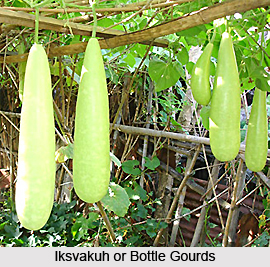 Iksvakuh is a well known Indian medicinal plant, bearing the botanical name of Lagenaria siceraria (Molina) Standley and it is commonly known as Bottle Gourd or Calabash Gourd in English. Iksvakuh is actually the Sanskrit name of the plant and this plant is also known as Katatumbi in Sanskrit. Kaddu is its Hindi name. Its other Hindi names are Kadutumbi, Kashiphal and Tumri. The plant has several other names in different native Indian languages. It is called as Kodulau, Lau, Tiktalau and in Bengali and in Gujarati, it is named as Dudhi, Dudio, Kadvitumbadi or Tumada. The Marathi names of the plant are Bhopala, Dudhya and Kadubho-Pla and the Punjabi speaking people known it as Ghiya, Golkaddu, Kabulikaddu, Keddi, Lauki and Tumba. While it is named as Shorakkai in Tamil, the Telugu speaking population calls it as Anapakai, Anugadaya, Gubbakaya, Kundanuga, Nelanuga or Sor-Rakaya.
Iksvakuh is a well known Indian medicinal plant, bearing the botanical name of Lagenaria siceraria (Molina) Standley and it is commonly known as Bottle Gourd or Calabash Gourd in English. Iksvakuh is actually the Sanskrit name of the plant and this plant is also known as Katatumbi in Sanskrit. Kaddu is its Hindi name. Its other Hindi names are Kadutumbi, Kashiphal and Tumri. The plant has several other names in different native Indian languages. It is called as Kodulau, Lau, Tiktalau and in Bengali and in Gujarati, it is named as Dudhi, Dudio, Kadvitumbadi or Tumada. The Marathi names of the plant are Bhopala, Dudhya and Kadubho-Pla and the Punjabi speaking people known it as Ghiya, Golkaddu, Kabulikaddu, Keddi, Lauki and Tumba. While it is named as Shorakkai in Tamil, the Telugu speaking population calls it as Anapakai, Anugadaya, Gubbakaya, Kundanuga, Nelanuga or Sor-Rakaya.
Iksvakuh is a large, pubescent, climbing or trailing herb, having stout, 5-angled stems and also bifid tendrils. The large leaves of the plant have a diameter of up to 15 cm and the ovate or orbicular leaves` base is cordate, with margins dentate. The leaves are usually 5-lobed. The plant`s petiole is long, with 2 glands at its apex. The flowers of Iksvakuh or Kaddu are large, white-coloured, solitary, and monoecious or dioecious. The male flowers are long and the females have short peduncles. The sub-campanulate calyx tube is of a funnel-shape, and it has 5 narrow teeth and 5 free petals. The petals are obovate, having a length of 2.5-5 cm and they are crumpled and hairy on both sides.
The fruits of the plant vary in size and shape; however, they are usually bottle-shaped. The fruits are up to 1.8 m long and they remain in a hard, durable, smooth shell. The numerous smooth seeds of the plant are of white colour, having a length of 1.6-2 cm and they are horizontally compressed with marginal groove. The plant is quite commonly found in all over India and its cultivated form is considered to be indigenous to India. The plant is mainly found throughout India in its wild state, and cultivated for its fruits that are eaten as a vegetable.
Iksvakuh has a large number of medicinal properties and usages and it is being used in various purposes in all over India. Two varieties (sweet- and bitter-fruited) of the plant have been distinguished in traditional Indian medicine. The Ayurvedic practitioners use the stem and fruit of the sweet-fruit variety in treating biliousness, and it is used for treating leucorrhoea, also. The leaves of the bitter-fruit variety are commonly used in the treatment of jaundice, leucorrhoea, vaginal and uterine complaints and earache. The fruit of the bitter-fruit variety is also used in treating asthma, bronchitis, inflammations, oedema, ulcers and pains. The Indian people apply a mixture of the ashes of the fruit and honey to the eyes to treat night blindness.
The fruit of the Iksvakuh plant is considered tonic to the liver, vulnerary, antiperiodic in Unani medicine and it is useful for relieving muscular pain and dry cough, as well. The ash of the fruit rind is styptic and vulnerary, while the flowers of the bitter-fruit variety are considered cooling in Unani practice. The flowers are considered useful for treating ophthalmia and toothache, and the fruits are considered useful for treating bronchitis, also. The Indian people prepare syrup from the tender fruit and use it as a pectoral. A mixture of the fruit juice and lime juice is used as an application for pimples and it also used to treat rheumatism, after being boiled in oil.
The Indian people apply the fruit pulp of Iksvakuh plant to the soles of their feet for getting relief from burning and they also used the seeds as an anthelmintic. Both the seeds and roots are used to treat dropsy, while the seed oil is applied externally to relieve headache. Apart from that, the Indian people give a mixture of a decoction of the plant`s leaves and sugar for treating jaundice, as well.



















